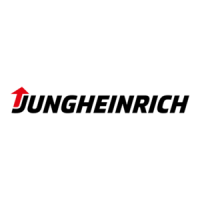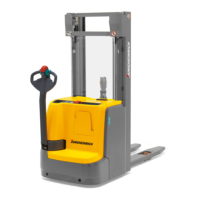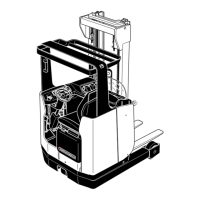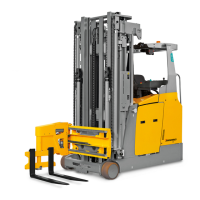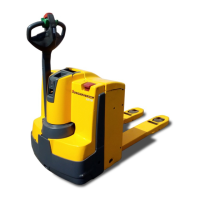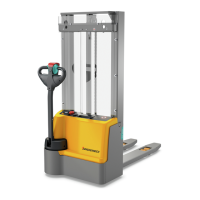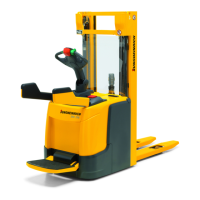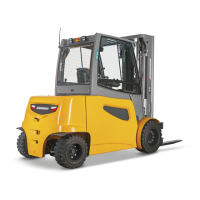1003.GB
B 6
Operating and Display Elements: Operating and display elements can be clearly
identified in the driver’s cab.
The Multi-Pilot (4) enables single handed operation of functions governing direction
of travel, lifting / lowering, mast forward / back, mast tilt, sideshift left or right in
sideshift mode (auxiliary hydraulic system HF5) (o)) and horn.
On the driver’s display panel (12) the battery discharge indicator and hourmeter are
grouped together. The discharge indicator is designed as a monitor which cuts out
lifting if the battery is low in order to avoid excessive discharge.
Hydraulic Equipment: Pump unit with an AC motor and a noiseless precision high
pressure pump. The equipment is controlled by the Multi-Pilot (4).
Electrical Equipment: 48 volt system in the form of a twin cable system. Series
electronic drive, lift and steering control.
The electronic drive control system governs the travel rate with infinite speed control
and permits regenerative braking when changing direction.
Drive and lift parameters can be set via the driver’s display unit (12). Warning
displays, operating errors and service functions can also be shown at the driver’s
display unit.
(For possible battery types, see Chapter D.)
2.2 Placing the Load
Mast holder: The mast holder is mounted on suppert rollers. A simple telescopic
pushing cylinder moves the holder backwards and forwards. The running rails for the
mast holder are bolted on to the outriggers (6. )
Lifting Frame: The trucks are equipped with telescopic free lift units situated in the
mast holder and which can be tilted. Adjustable side rollers and slide pieces take up
the pressure exerted on the fork carriage if the load is positioned on one side. The
fork arms are fitted to the fork carriage and are adjustable. With the twin lift Triplex
mast (DZ) the first lift of the load carriage (free lift) is produced by a short, externally
fitted lift cylinder (3) without changing the construction height. With a telescopic mast
(ZT) the free lift is limited to 80 mm due to the design.
Attachments: Hydraulic and mechanical attachments are possible.
1003.GB
B 6
Operating and Display Elements: Operating and display elements can be clearly
identified in the driver’s cab.
The Multi-Pilot (4) enables single handed operation of functions governing direction
of travel, lifting / lowering, mast forward / back, mast tilt, sideshift left or right in
sideshift mode (auxiliary hydraulic system HF5) (o)) and horn.
On the driver’s display panel (12) the battery discharge indicator and hourmeter are
grouped together. The discharge indicator is designed as a monitor which cuts out
lifting if the battery is low in order to avoid excessive discharge.
Hydraulic Equipment: Pump unit with an AC motor and a noiseless precision high
pressure pump. The equipment is controlled by the Multi-Pilot (4).
Electrical Equipment: 48 volt system in the form of a twin cable system. Series
electronic drive, lift and steering control.
The electronic drive control system governs the travel rate with infinite speed control
and permits regenerative braking when changing direction.
Drive and lift parameters can be set via the driver’s display unit (12). Warning
displays, operating errors and service functions can also be shown at the driver’s
display unit.
(For possible battery types, see Chapter D.)
2.2 Placing the Load
Mast holder: The mast holder is mounted on suppert rollers. A simple telescopic
pushing cylinder moves the holder backwards and forwards. The running rails for the
mast holder are bolted on to the outriggers (6. )
Lifting Frame: The trucks are equipped with telescopic free lift units situated in the
mast holder and which can be tilted. Adjustable side rollers and slide pieces take up
the pressure exerted on the fork carriage if the load is positioned on one side. The
fork arms are fitted to the fork carriage and are adjustable. With the twin lift Triplex
mast (DZ) the first lift of the load carriage (free lift) is produced by a short, externally
fitted lift cylinder (3) without changing the construction height. With a telescopic mast
(ZT) the free lift is limited to 80 mm due to the design.
Attachments: Hydraulic and mechanical attachments are possible.
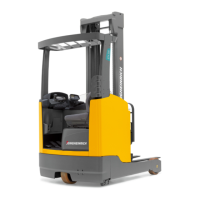
